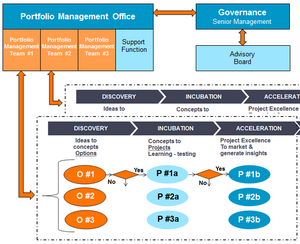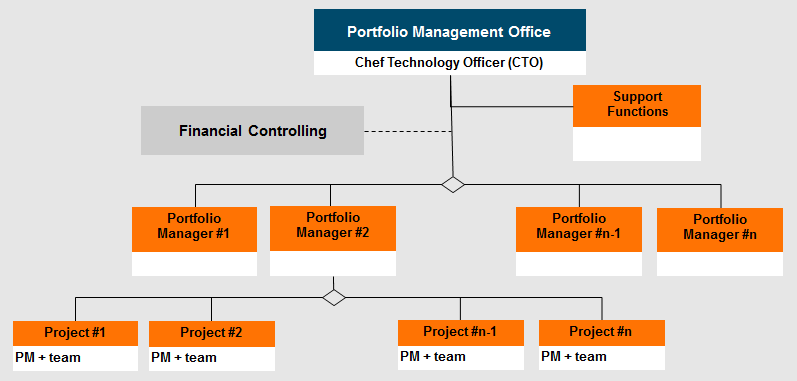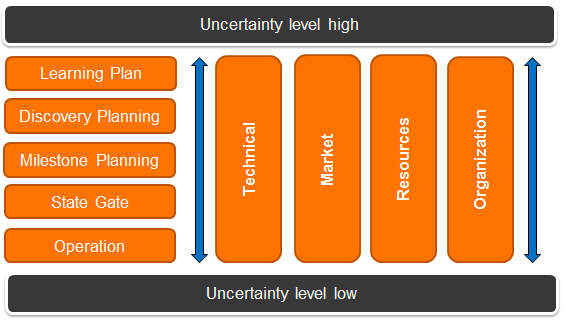The importance of Organizational Structures in Portfolio Management
| Line 15: | Line 15: | ||
Project Management is a mature discipline with a great variety of tools supporting the project manager and team to timely delivery of the right product or service at the right level of quality; however the real value is only harvested when the completion of the project benefits the business and improve the competitive position. The rapid changes in the competitive landscape require constant alignment with the strategic direction of the enterprise. Projects constantly not being monitored and assessed with focus on benefit, risk and alignment with the overall strategy of the enterprise tend to fall short and potentially drain the organization of financial and human resources at the expense other more beneficial projects. One way of dealing with the increase in complexity and the significant increase in the use of projects as a method to deal with challenges is to introduce the business practice of Project Portfolio Management <ref name="PPM"/> | Project Management is a mature discipline with a great variety of tools supporting the project manager and team to timely delivery of the right product or service at the right level of quality; however the real value is only harvested when the completion of the project benefits the business and improve the competitive position. The rapid changes in the competitive landscape require constant alignment with the strategic direction of the enterprise. Projects constantly not being monitored and assessed with focus on benefit, risk and alignment with the overall strategy of the enterprise tend to fall short and potentially drain the organization of financial and human resources at the expense other more beneficial projects. One way of dealing with the increase in complexity and the significant increase in the use of projects as a method to deal with challenges is to introduce the business practice of Project Portfolio Management <ref name="PPM"/> | ||
| − | In the highly recommendable book on Project Folio Management by Levine PPM is defined as | + | In the highly recommendable book on Project Folio Management by Levine PPM is defined as “''Project portfolio management is a set of business practices that brings the world of projects into tight integration with other business operations. It brings projects into harmony with the strategies, resources, and executive oversight of the enterprise and provides the structure and processes for project portfolio governance''”<ref name="PPM"/>. The successful implementation of PPM requires a transformation of the organization involving significant changes to the roles and responsibilities of not just the upper management level but to the entire organization - a new organizational design is needed. |
Revision as of 09:30, 28 February 2019
Contents |
Abstract
The success of any organization – being a commercial company, public or non-profit organization – is highly dependent on the level of alignment the organization is able to execute on. The mission and vision statement of an organization expresses the end goal – the North Star. In order to achieve these goals, a strategy – the game plan of how to get there – is formulated. In order to execute on the strategy, a carefully selected collection of capabilities that suits and enables the strategy most be established - the organizational setup and design is critical. The success criteria’s of and the organizations ability to execute right projects is closely linked to their ability to design and structure the organization [1]. The purpose of introducing Project Portfolio Management (PPM) is to establish and formalize an entity that provides insight and transparency for the senior management to constantly align the activities (projects) with the strategy and thereby utilizing the limited economic and human resources of the organization in the best possible way [2].
The introduction of PPM as a collection business practices impose complexity on to the organization that cannot be accommodated by the classical organizational structures. The purpose of this article is to address and stress the importance of organizational design - including organizational structures needed for a Project Portfolio Management organization to be effective in and co-existence with a classical line organization - in order for the enterprise to become successful. The article addresses the important concepts and the application of how to obtain an optimal organization design that is needed to execute on the strategy of the organization. It provides the tools and accumulated experience in order to become a good and successful practitioner.
Structure of this article
- This article starts with a short description on: Portfolio Management, Organizational structures and the relationship between them, in order to obtain a fundamental knowledge of the subject and set the scene for the rest of the article.
- The second section elaborates on the application and usability of organizational structures in portfolio management. The theories behind will be address and explained into detail.
- Lastly, the challenges and limitations will be addressed and discussed.
(Section will be elaborated)
Background
Project Management is a mature discipline with a great variety of tools supporting the project manager and team to timely delivery of the right product or service at the right level of quality; however the real value is only harvested when the completion of the project benefits the business and improve the competitive position. The rapid changes in the competitive landscape require constant alignment with the strategic direction of the enterprise. Projects constantly not being monitored and assessed with focus on benefit, risk and alignment with the overall strategy of the enterprise tend to fall short and potentially drain the organization of financial and human resources at the expense other more beneficial projects. One way of dealing with the increase in complexity and the significant increase in the use of projects as a method to deal with challenges is to introduce the business practice of Project Portfolio Management [2]
In the highly recommendable book on Project Folio Management by Levine PPM is defined as “Project portfolio management is a set of business practices that brings the world of projects into tight integration with other business operations. It brings projects into harmony with the strategies, resources, and executive oversight of the enterprise and provides the structure and processes for project portfolio governance”[2]. The successful implementation of PPM requires a transformation of the organization involving significant changes to the roles and responsibilities of not just the upper management level but to the entire organization - a new organizational design is needed.
Managing Portfolios
According to MoP: Management of Portfolios Portfolio management is: “Portfolio management is a coordinated collection of strategic processes and decisions that together enable the most effective balance of organizational change and BAU.” [3].The portfolio management office host and provides infrastructure for the portfolio management teams, i.e. providing standard operating procedures for the tracking, reporting and managing activities in a unified and comparable way. In contrast to the functional organization structure applied in many companies, the portfolio management office including the portfolio and product managers has a fairly small number of permanent staff members and relies on the ability to set up project and manage the project team composition as the project moves through the different stages. The different stages are industry dependent in terms of complexity and timeline – significant differences can be observed between consumer electronics and pharmaceutical. In the ideation phase it is all about managing uncertainty – we limited knowledge about the market, the technology, the resources required and the organization. The composition of the project team will change as the project progress towards handing over to the company’s delivery organization and the uncertainty is transformed into risk management, i.e. time and spends.
Organizational structures
An organizational structure is a formal visualization of a system of tasks and the reporting relations, that coordinates and motivates the employees, so they efficiently can work together to achieve the goals of the organization. Having an organizational structure can help the organization improve efficiently by balancing the influencing factors such as external environment, strategy, technology and human resources [4]. There are several types of organizational structures, e.g. functional, matrix or divisional structures, which will be elaborated more on later in the article. It is a work of art to select and design a proper structure for an organization, which increase the efficiency and effectiveness of the organization. It is not easy and should not be taken for granted.
The success of any organization – being a commercial company or non-profit organization – is highly dependent on the level of alignment the organization is able to execute on. It is therefore important to focus on the structure of the organization and make a virtue out of designing the best possible structure that suits your organization and its goals the best. If the organizational structure is not in alignment with the strategy of the organization, it creates a friction which shows the inability to mobilize resources right, decision-making and information flow lacks and the execution of the strategy becomes ineffective[1].
Mapping the portfolio management onto an organizational structure
Application/Usability
Challenges and Limitations
Annotated Bibliography
References
- ↑ 1.0 1.1 Kates, A. & Galbraith, J. (2007). Designing Your Organization: Using the Star Model to Solve Five Critical Design Challenges.
- ↑ 2.0 2.1 2.2 2.3 Levine, H. A. (2005). Project Portfolio Management: A Practical Guide to Selecting Projects, Managing Portfolios, and Maximizing Benefits. Jossey-Bass.
- ↑ Office Of Government Commerce (2011). Management of Portfolios. TSO.
- ↑ Jones, G. R. & George, J. M. (2015). Essentials of Contemporary Management(5th edit.). New York: McGraw-Hill Education, Chapter 7.
- ↑ O'Connor, G. C., Leifer, R., Paulson, A. S., & Peters, L. S. (2008). Grabbing Lightning. San Francisco: Jossey-Bass.
- ↑ Hyland, J., & Arteaga, R. (2014). Pivot: How Top Entrepreneurs Adapt and Change Course to Find Ultimate Success. New Jersey: John Wiley & Sons.
- ↑ Cooper et al 2001


